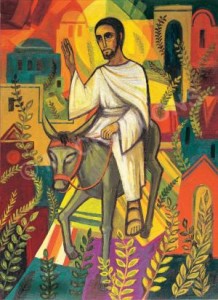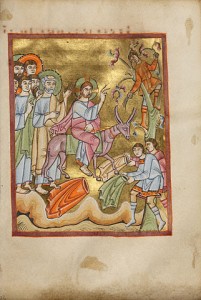Thoughts on Today’s Lessons for Sunday, April 13, 2014
Procession: Liturgy of the Palms APsalm: Psalm 118:1-2, 19-29
As we celebrate Palm Sunday, recalling Jesus’ traditional entry into Jerusalem before a cheering crowd, these verses from Psalm 118 portray another festive procession in honor of our Lord and God; in familiar words we celebrate “the day that the Lord has made; let us rejoice and be glad in it!”
Gospel: Matthew 21:1-11
Matthew tells of Jesus’s triumphal procession into the city, complete with the odd image of Jesus riding two animals at once, recalling Zechariah’s prophecy that Israel’s shepherd-king would come, “mounted on a donkey, and on a colt.” It is an exciting time: Crowds surround Jesus, and he has warned the disciples that he will be mocked, flogged and crucified. Soon he will anger the authorities again when he drives the money-changers out of the temple, as the narrative leads inexorably to his passion and death on the cross.
Liturgy of the Passion A
First Reading: Isaiah 50:4-9a
This song of the Prophet Isaiah is called “the suffering servant.” Written about the people in exile in Babylon, it looks forward to a servant leader who will guide them back home to Jerusalem. Christian readers can hardly encounter these verses, though, without thinking of Jesus, our messiah and king, who suffered for us and who taught us to give our backs and turn our cheeks to those who strike us.
Psalm: Psalm 31:9-16
Suffering continues in this Psalm of lament, as the Psalmist recites a litany of sorrow, distress, grief, sighing, misery, scorn, horror, dread and more. He suffers, his neighbors scheme; they plot his death. Yet amid all this misery, hope glows like the sun breaking through clouds: Trust in God, place our faith in God’s love, and wait to be saved.
Second Reading: Philippians 2:5-11
Might Paul have had Isaiah’s “suffering servant” in mind as he wrote of Jesus’ death on the cross? We understand Jesus as both fully human and fully divine, yet he was willing to set aside his divinity – “emptying himself” – to bear the horrific pain of crucifixion as a vulnerable, frightened human. Jesus took on the full weight of all that suffering to show us the true exaltation of God’s love, calling us only to respond with love for God and our neighbor.
Gospel: Matthew 26:14 – 27:66
There’s a lot packed into this long Gospel, from the Last Supper to the crucifixion; but let’s focus for a moment on just one point: When Jesus warned the apostles that one of them would betray him, they all fretted. Every one wondered if he could turn traitor. One after another they asked, ‘Surely not I, Lord?” No matter how much we think we love, deep inside we worry. Like the apostles, we all know we are human, frail and weak. Yet Jesus, taking up the cross for our sake, loves us all the same.


